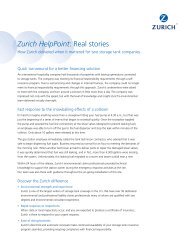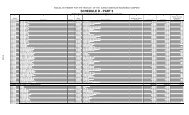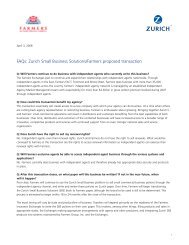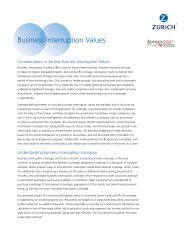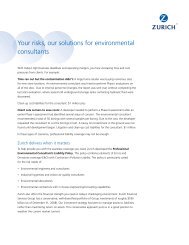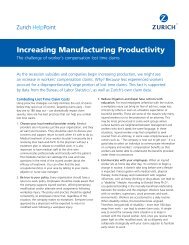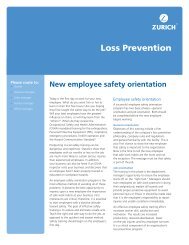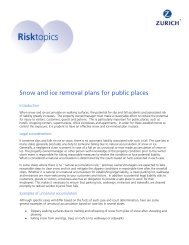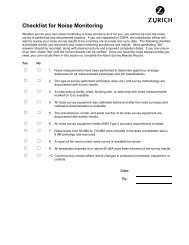ZAIC2012-1 - Zurich Producer Compensation
ZAIC2012-1 - Zurich Producer Compensation
ZAIC2012-1 - Zurich Producer Compensation
Create successful ePaper yourself
Turn your PDF publications into a flip-book with our unique Google optimized e-Paper software.
ANNUAL STATEMENT FOR THE YEAR 2012 OF THE ZURICH AMERICAN INSURANCE COMPANY<br />
In addition, the Company uses the following accounting policies:<br />
1. Short-term investments are stated at amortized cost.<br />
2. Bonds not backed by other loans are stated at amortized cost except for bonds rated NAIC 3 or below, which are carried at the<br />
lower of amortized cost or fair value. The amortized cost of bonds, which is determined using the interest method, is adjusted<br />
for amortization of premium and accretion of discount using a level effective yield to maturity. Such amortization or accretion is<br />
included in investment income. Bonds that are classified as non-investment grade where it is determined that the collection of<br />
all contractual cash flows is not probable, are written down to the current market value and the difference is recorded as a<br />
realized loss.<br />
3. Investments in unaffiliated common stocks are generally carried at fair market value, with the unrealized gains or losses<br />
reflected in unassigned surplus. The cost basis of common stocks is written down to market value and recorded as a realized<br />
loss when market value has been significantly below cost for an extended length of time and a determination is made that the<br />
financial condition or future prospects of the investee has deteriorated such that the decline in value is considered other-thantemporary.<br />
4. Redeemable preferred stocks are stated at amortized cost. The amortized cost of the preferred stock is adjusted for<br />
amortization of premiums and accretion of discounts using a level of effective yield to maturity method. Such amortization or<br />
accretion is included in investment income. Preferred stock that are classified as non-investment grade where it is determined<br />
that collection of all contractual cash flows is not probable, are written down to the current market value and the difference is<br />
recorded as a realized loss.<br />
5. The Company has no investments in mortgage loans.<br />
6. Loan-backed securities are stated at amortized cost except for such securities rated NAIC 3 or below which are stated at the<br />
lower of amortized cost or fair market value. Amortization of discount or premium on mortgage-backed and asset-backed<br />
securities is recognized based on the estimated timing and amount of prepayments of the underlying assets. For all securities,<br />
except interest only securities or other securities where the yield has become negative, the amortization of discount or<br />
premium is adjusted using the retrospective method to reflect differences which arise between the prepayments originally<br />
anticipated and the actual prepayments received and currently anticipated. To the extent the estimated lives of such securities<br />
change as a result of changes in prepayment rates, the adjustment is included in investment income. For all interest only<br />
securities or other securities where the yield has become negative, the Company uses the prospective method for amortization<br />
of discount or premium. Loan backed securities with evidence of deterioration of credit quality where the Company has the<br />
intent and ability to hold, and for which it is probable that the Company will be unable to collect all contractual cashflows, are<br />
written down to the present value of expected cash flows calculated using the discount rate at the original acquisition.<br />
7. Investments in common stock of U.S. based affiliated insurance companies are carried at the underlying statutory equity as<br />
reflected in the respective entity’s financial statements. Investments in common stock of non-U.S. based insurance companies<br />
are carried at the underlying audited U.S. Generally Accepted Accounting Principles (GAAP) equity of the investee, adjusted to<br />
a statutory basis of accounting.<br />
8. The Company has minor ownership interests in joint ventures and partnerships. The Company carries these interests based<br />
on the underlying audited GAAP equity of the investee.<br />
9. The Company has no investments in derivatives.<br />
10. The Company anticipates investment income as a factor in determining premium deficiency reserves. As of December 31,<br />
2012, the Company did not record a premium deficiency reserve.<br />
11. See Note 1C, paragraphs 2 and 3 above for Company’s methodologies for estimating liabilities for losses and loss/claim<br />
adjustment expenses.<br />
12. The Company has not modified its capitalization policy from the prior year.<br />
13. The Company has no pharmaceutical rebate receivables.<br />
2. ACCOUNTING CHANGES AND CORRECTIONS OF ERRORS<br />
Effective January 1, 2012, the Company adopted SSAP No. 101, Income Taxes, A Replacement of SSAP No. 10R and SSAP No. 10.<br />
SSAP No. 101 contains changes to accounting for current and deferred federal income taxes. This guidance provides that the deferred<br />
tax asset admissibility guidance is no longer elective, and the reversal and surplus limitation parameters in the admissibility tests are<br />
determined based on the risk-based capital level. It also requires gross deferred tax assets to be reduced by a statutory valuation<br />
allowance if it is more likely than not that some portion or all of the gross deferred tax assets will not be realized. The guidance also sets a<br />
more likely than not threshold for the recording of contingent tax liabilities. The cumulative effect of adopting this pronouncement is $0.<br />
Effective December 31, 2012, the Company adopted changes to SSAP No. 62R, Property and Casualty Reinsurance. SSAP No. 62R<br />
contains changes to accounting for reinsurance ceded to certified reinsurers. This guidance defines a certified reinsurer as "an assuming<br />
insurer that does not meet the requirements to be considered authorized in the domestic state of the ceding insurer, but has been certified<br />
by such state and is required to provide collateral as security for its reinsurance obligations incurred under contracts entered into or<br />
renewed on or after the effective date of certification." As a result, ceding reinsurers are allowed to accept less collateral from certified<br />
reinsurers without incurring an additional provision for reinsurance liability. The cumulative effect of adopting this updated pronouncement<br />
is $0.<br />
3. BUSINESS COMBINATIONS AND GOODWILL<br />
None<br />
4. DISCONTINUED OPERATIONS<br />
None<br />
5. INVESTMENTS<br />
A. The Company has no investments in mortgage loans.<br />
B. The Company did not have any debt restructuring during 2012.<br />
14.1



